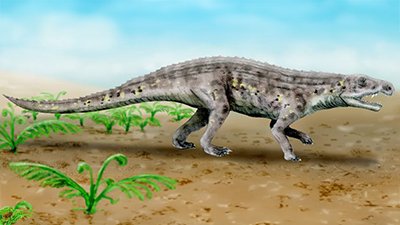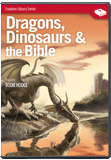Dinosaurs and the Bible
An aura of mystery surrounds the dinosaurs. Where did they come from? Did they evolve? Did they really live millions of years ago? What happened to them? Are there any living today? Has any human being ever seen a live dinosaur?
Children and adults alike are absolutely fascinated by these mysterious monsters. Numerous books and movies have been produced to satisfy a seemingly insatiable hunger for information on these puzzling creatures. The truth of the matter, however, is that there are no real mysteries at all, once you have key information that is not generally known and is withheld from the public.
Come with me as we take a walk through history and uncover some amazing facts that will answer many of your questions about these “terrible lizards.”
Did Dinosaurs Really Exist?
Dinosaurs certainly did roam the Earth in the ancient past! Fossils of dinosaurs have been found all over the world, and their bones are displayed in museums for all to see. Scientists have been able to reconstruct many of their skeletons, so we know much about how they may have looked.
When Were Dinosaurs Found?
The story of their discovery began back in the 1820s, when Gideon Mantell, an English doctor, found some unusual teeth and bones in a quarry. Dr Mantell realized there was something very different about these animal remains, and believed that he had found an entirely new group of reptiles. By 1841, about nine types of these different reptiles had been uncovered, including two called Megalosaurus and Iguanodon.
At this time, a famous British scientist, Dr Richard Owen, coined the name “Dinosauria,” meaning “terrible lizard,” for this is what the huge bones made him think of.
What Makes Dinosaurs Different?

Other than the huge size of some dinosaurs, the major feature that really distinguishes dinosaurs from other reptiles (such as crocodiles) is the position of their limbs. Dinosaurs had posture that was fully erect, similar to that in mammals. Most other reptiles have limbs in a sprawling position. For instance, compare the way a crocodile “walks” with that of, say, a cow. Dinosaurs would have moved like a cow, with the limbs supporting the body from beneath. Crocodiles “waddle,” as their limbs project sideways from their body.
How Big Were Dinosaurs?
Some were as small as chickens, and others were even smaller. Of course, some dinosaurs were very large, weighing in at an estimated 80 tons and standing 40 feet high! The average size of a dinosaur, however, was probably about that of a large sheep or bison.
When Did Dinosaurs Live?
The story we have all heard from movies, television, newspapers, and most magazines and textbooks is that dinosaurs lived millions of years ago. According to evolutionists, the dinosaurs “ruled the Earth” for 140 million years, dying out about 65 million years ago. However, scientists do not dig up anything labeled with those ages. They only uncover dead dinosaurs (i.e., their bones), and their bones do not have labels attached telling how old they are. The idea of millions of years of evolution is just the evolutionists’ story about the past. No scientist was there to see the dinosaurs live through this supposed dinosaur age. In fact, there is no proof whatsoever that the world and its fossil layers are millions of years old. No scientist observed dinosaurs die. Scientists only find the bones in the here and now, and because many of them are evolutionists, they try to fit the story of the dinosaurs into their view.
Other scientists, called creation scientists, have a different idea about when dinosaurs lived.
Other scientists, called creation scientists, have a different idea about when dinosaurs lived. They believe they can solve any of the supposed dinosaur mysteries and show how the evidence fits wonderfully with their ideas about the past, beliefs that come from the Bible.
The Bible, God’s very special book (or collection of books, really), claims that each writer was supernaturally inspired to write exactly what the Creator of all things wanted him to write down for us so that we can know where we (and dinosaurs) came from, why we are here, and what our future will be. The first book in the Bible—Genesis—teaches us many things about how the universe and life came into existence. Genesis tells us that God created everything—the Earth, stars, sun, moon, plants, animals, and the first two people.
Although the Bible does not tell us exactly how long ago it was that God made the world and its creatures, we can make a good estimate of the date of creation by reading through the Bible and noting some interesting passages:
- God made everything in six days. He did this, by the way, to set a pattern for mankind, which has become our seven day week (as described in Exodus 20:11). God worked for six days and rested for one, as a model for us. Furthermore, Bible scholars will tell you that the Hebrew word for day used in Genesis 1, can only mean an ordinary day in this context.
- We are told God created the first man and woman—Adam and Eve—on Day Six. Many facts about when their children and their children’s children were born are given in Genesis. These genealogies are recorded throughout the Old Testament, up until the time of Christ. They certainly were not chronologies lasting millions of years.
As you add up all of the dates, and accepting that Jesus Christ, the Son of God, came to Earth almost 2000 years ago, we come to the conclusion that the creation of the Earth and animals (including the dinosaurs) occurred only thousands of years ago (perhaps only 6000!), not millions of years. Thus, if the Bible is right (and it is!), dinosaurs must have lived within the past thousands of years.
Where Did Dinosaurs Come From?
Evolutionists claim that dinosaurs evolved over millions of years. They imagine that one kind of animal slowly changed over long periods of time to become a different kind of animal. For instance, they believe that amphibians changed into reptiles (including dinosaurs) by this gradual process. This would mean, of course, that there would have been millions of creatures during that time that would be “in between,” as amphibians evolved into reptiles. Evidence of these “transitional forms,” as they are called, should be abundant. However, many fossil experts admit that not one unquestionable transitional form between any group of creatures and another has been found anywhere. If dinosaurs evolved from amphibians, there should be, for example, fossil evidence of animals that are part dinosaur and part something else. However, there is no proof of this anywhere. In fact, if you go into any museum you will see fossils of dinosaurs that are 100% dinosaur, not something in between. There are no 25%, 50%, 75%, or even 99% dinosaurs—they are all 100% dinosaur!
The Bible tells us that God created all of the land animals on the sixth day of creation. As dinosaurs were land animals, they must have been made on this day, alongside Adam and Eve, who were also created on Day Six (Genesis 1:24–31). If God designed and created dinosaurs, they would have been fully functional, designed to do what they were created for, and would have been 100% dinosaur. This fits exactly with the evidence from the fossil record.
Evolutionists declare that no man ever lived alongside dinosaurs. The Bible, however, makes it plain that dinosaurs and people must have lived together. Actually, as we will soon see, there is a lot of evidence for this.
What Did Dinosaurs Eat?
The Bible teaches (in Genesis 1:29–30) that the original animals (and the first humans) were commanded to be vegetarian. There were no meat eaters in the original creation. Furthermore, there was no death. It was an unblemished world, with Adam and Eve and animals (including dinosaurs) living in perfect harmony, eating only plants.
Sadly, it did not stay this way for very long. Adam rebelled against his Creator, bringing sin into the world (Genesis 3:1–7; Romans 5:12). Because of this rebellion, Adam, and thus all of his descendants (you and me), gave up the right to live with a Holy (sinless) and just God. God therefore judged sin with death.
The Bible plainly teaches from Genesis to Revelation that there was no death of animals or humans before Adam sinned. (Consider just a few of the many passages, such as: Romans 5:12; Genesis 2:17; Genesis 1:29–30; Romans 8:20–22; Acts 3:21; Hebrews 9:22; 1 Corinthians 15; Revelation 21:1–4; Revelation 22:3.) This means there could not have been any animal fossils (and no dinosaur bones) before sin.
After Adam’s sin, animals and people started to die. It was now a different world, one of death and strife. A world that was once beautiful now suffered under the curse placed upon it by the Creator (Genesis 3:14–19). But a promise was given (Genesis 3:15) that God would provide a way for the penalty of sin to be paid so there would be a way for man to come back to God.
Why Do We Find Dinosaur Fossils?
In Genesis 6, we read that all flesh (man and animals) had “corrupted his way upon the Earth” (Genesis 6:12). Perhaps people and animals were killing each other; maybe dinosaurs had started killing other animals and humans. In any case, the Bible describes the world as “wicked.”
Because of this wickedness, God warned a godly man named Noah that He was going to destroy the world with a Flood (Genesis 6:13). God therefore commanded him to build a great ship (the Ark) so that all the kinds of land animals (which must have included dinosaurs) and Noah’s family could survive on board while the Flood destroyed the entire Earth (Genesis 6:14–20).
Some people think that dinosaurs were too big, or there were too many of them, to go on this Ark. However, there were not very many different kinds of dinosaurs. There are certainly hundreds of dinosaur names, but many of these were given to just a bit of bone or skeletons of the same dinosaur found in other countries. It is also reasonable to assume that different sizes, varieties, and sexes of the same kind of dinosaur have ended up with different names. For example, look at the many different varieties and sizes of dogs, but they are all the same kind—the dog kind! In reality, there may have been fewer than 50 kinds of dinosaurs.
God sent two of every (seven of some) land animal into the Ark (Genesis 7:2–3; 7:8–9)—there were no exceptions. Therefore, dinosaurs must have been on the Ark. Even though there was ample room in the huge ship for large animals, perhaps God sent young adults into the Ark that still had plenty of room for them to grow.
Well, what happened to all the land animals that did not go on the Ark? Very simply, they drowned. Many would have been covered with tons of mud as the rampaging water covered the land (Genesis 7:11–12,19). Because of this quick burial, many of the animals would have been preserved as fossils. If this happened, you would expect to find evidence of billions of dead things buried in rock layers (formed from this mud) all over the Earth. This is exactly what you do find.
By the way, the Flood of Noah’s day probably occurred just over 4,500 years ago. Creationists believe that this event formed many of the fossil layers around the Earth. (Additional fossil layers were formed by other floods as the Earth settled down after the great Flood.) Thus, the dinosaur fossils which were formed as a result of this Flood were probably formed about 4,500 years ago, not millions of years ago.
Have Dinosaurs Lived in Recent Times?
If the different kinds of dinosaurs survived the Flood, then they must have come off the Ark and lived in the post-Flood world.
In the Bible, in Job 40:15–24, God describes to Job (who lived after the Flood) a great beast with which Job was familiar. This great animal, called “behemoth,” is described as “the chief of the ways of God,” perhaps the biggest land animal God had created. Impressively, he moved his tail like a cedar tree! Although some Bible commentaries say this may have been an elephant or hippopotamus, the description actually fits that of a dinosaur like Brachiosaurus. Elephants and hippos certainly do not have tails like cedar trees!

Actually, very few animals are singled out in the Bible for such a detailed description. Contrary to what many may think, what we know now as dinosaurs get more mention in the Scriptures than most animals! So dinosaurs—all the different kinds—must have lived alongside of people after the Flood.
Are Dinosaurs Mentioned in Ancient Literature?
Interestingly, the word “dragon” is used a number of times in the Old Testament. In most instances, the word dinosaur could substitute for dragon and it would fit very nicely. Creation scientists believe that dinosaurs were called dragons before the word dinosaur was invented in the 1800s. We would not expect to find the word dinosaur in Bibles like the Authorized Version (1611), as it was translated well before the word dinosaur was ever used.
Also, there are many very old history books in various libraries around the world that have detailed records of dragons and their encounters with people. Surprisingly (or not so surprisingly for creationists), many of these descriptions of dragons fit with how modern scientists would describe dinosaurs, even Tyrannosaurus. Unfortunately, this evidence is not considered valid by evolutionists. Why? Only because their belief is that man and dinosaurs did not live at the same time!
However, the more we research the historical literature, the more we realize there is overwhelming evidence that dragons were real beasts, much like our modern reconstructions of dinosaurs, and that their existence has been recorded by many different people, even just hundreds of years ago.
What Happened to Dinosaurs?
Evolutionists use their imagination in a big way in answering this question. Because of their belief that dinosaurs “ruled” the world for millions of years, and then disappeared millions of years before man allegedly evolved, they have had to come up with all sorts of guesses to explain this “mysterious” disappearance.
When reading evolutionist literature, you will be astonished at the range of ideas concerning their supposed extinction. The following is just a small list of theories:
Dinosaurs starved to death; they died from overeating; they were poisoned; they became blind from cataracts and could not reproduce; mammals ate their eggs. Other causes include volcanic dust, poisonous gases, comets, sunspots, meteorites, mass suicide, constipation, parasites, shrinking brain (and greater stupidity), slipped discs, changes in the composition of air, etc.
It is obvious that evolutionists don’t know what happened and are grasping at straws. In a recent evolutionary book on dinosaurs, “A New Look At the Dinosaurs,” the author made the statement:
Now comes the important question. What caused all these extinctions at one particular point in time, approximately 65 million years ago? Dozens of reasons have been suggested, some serious and sensible, others quite crazy, and yet others merely as a joke. Every year people come up with new theories on this thorny problem. The trouble is that if we are to find just one reason to account for them all, it would have to explain the death, all at the same time, of animals living on land and of animals living in the sea; but, in both cases, of only some of those animals, for many of the land dwellers and many of the sea-dwellers went on living quite happily into the following period. Alas, no such one explanation exists (Alan Charig, p. 150).
But, one such explanation does exist. If you remove the evolutionary framework, get rid of the millions of years, and then take the Bible seriously, you will find an explanation that fits the facts and makes perfect sense:
At the time of the Flood, many of the sea creatures died, but some survived. In addition, all of the land creatures outside the Ark died, but the representatives of all the kinds that survived on the Ark lived in the new world after the Flood. Those land animals (including dinosaurs) found the new world to be much different than the one before the Flood. Due to (1) competition for food that was no longer in abundance, (2) other catastrophes, (3) man killing for food (and perhaps for fun), and (4) the destruction of habitats, etc., many species of animals eventually died out. The group of animals we now call dinosaurs just happened to die out too. In fact, quite a number of animals become extinct each year. Extinction seems to be the rule in Earth history (not the formation of new types of animals as you would expect from evolution).
Will We Ever See a Live Dinosaur?
The answer is probably not … but, then again? There are some scientists who believe a few dinosaurs may have survived in remote jungles. We are still discovering new species of animals and plants today in areas that have been too difficult to explore until now. Even natives in some countries describe beasts that fit with what might be a dinosaur.
Creationists, of course, would not be surprised if someone found a living dinosaur. However, evolutionists would then have to explain why they made dogmatic statements that man and dinosaur never lived at the same time. I suspect they would say something to the effect that this dinosaur somehow survived because it was trapped in a remote area that has not changed for millions of years. You see, no matter what is found, or how embarrassing it is to evolutionists’ ideas, they will always be able to concoct an “answer” because evolution is a belief. It is not science—it is not fact!
What Lessons Can We Learn From the Dinosaur?
When we see the bones of dinosaurs, we can be reminded that death was not a part of the original creation. Death is actually an intruder, entering when the first man disobeyed God. The Bible tells us that because we are all descendants of Adam, we too have sinned: “Wherefore, as by one man sin entered into the world, and death by sin; and so death passed upon all men, for that all have sinned” (Romans 5:12); “For all have sinned and come short of the glory of God” (Romans 3:23). We need to recognize that the wickedness in the world is because of sin, because man rebelled against God.
We can also be reminded that God, who made all things, including the dinosaurs, is also a judge of His creation.
We can also be reminded that God, who made all things, including the dinosaurs, is also a judge of His creation. He judged Adam’s rebellion by cursing the world with death. Adam was warned about what would happen if he disobeyed God’s instruction not to eat the fruit of one particular tree. “But of the tree of the knowledge of good and evil, thou shalt not eat of it: for in the day that thou eatest thereof thou shalt surely die” (Genesis 2:17).
Dinosaurs can also remind us that God judged the rebellion in Noah’s day by destroying the wicked world with water, resulting in the death of millions of creatures. The Bible teaches us that He will again judge the world, but next time by fire: “But the day of the Lord will come as a thief in the night; in which the heavens shall pass away with a great noise, and the elements shall melt with fervent heat, the Earth also and the works that are therein shall be burned up” (2 Peter 3:10).
We can also be reminded that after this judgment by fire, God will make a new heaven and Earth: “Nevertheless we, according to His promise, look for new heavens and a new Earth, wherein dwelleth righteousness” (2 Peter 3:13). And what will it be like in this new Earth? “And God shall wipe away all tears from their eyes; and there shall be no more death, neither sorrow, nor crying, neither shall there be any more pain: for the former things are passed away” (Revelation 21:4).
But we are also warned that many will not be allowed into this new Earth but will suffer for eternity: “But the fearful, and unbelieving, and the abominable, and murderers, and whoremongers, and sorcerers, and idolaters, and all liars, shall have their part in the lake which burneth with fire and brimstone: which is the second death” (Revelation 21:8).
Humans, who are all sinful from conception (Psalm 51:5), cannot live with a Holy God, but are condemned to separation from God. But, God provided a wonderful means of deliverance from sin. The Bible teaches that God offered the perfect sacrifice needed to pay the penalty for man’s sin. God’s own Son, the one who in fact created the world (Colossians 1:16), came to Earth as a man, as a descendant of Adam, to suffer the death penalty for sin. “But now is Christ risen from the dead, and become the firstfruits of them that slept. For since by man came death, by man came also the resurrection of the dead. For as in Adam all die, even so in Christ shall all be made alive” (1 Corinthians 15:20–22).
The Lord Jesus Christ died on a cross, but on the third day, rose again, conquering death, so that anyone who believes in Him and accepts Him into his or her life, is able to come back to God and live for eternity with the Creator. “For God so loved the world, that He gave His only begotten Son, that whosoever believeth in Him should not perish, but have everlasting life” (John 3:16); “If we confess our sins, He is faithful and just to forgive us our sins, and to cleanse us from all unrighteousness” (1 John 1:9).
For those who do not accept by faith what Christ has done for them and do not recognize their sinful nature and need for redemption, the Bible warns that such people will live forever, but will be separated from God in a place of torment that the Bible calls Hell. But for those who commit their lives to the Lord—what a wonderful message! What a wonderful Savior! What a wonderful salvation in Christ the Creator!
If you, the reader of this web page, want to know more about how you can spend eternity with the God of creation, please read on about the Gospel of Jesus Christ.
Recommended Resources

Answers in Genesis is an apologetics ministry, dedicated to helping Christians defend their faith and proclaim the good news of Jesus Christ.
- Customer Service 800.778.3390
- © 2025 Answers in Genesis











